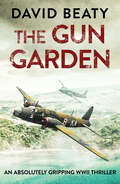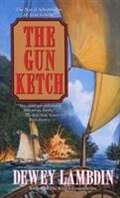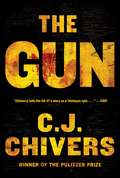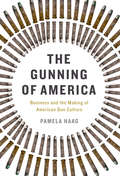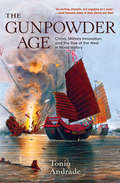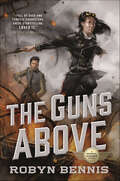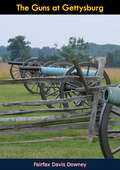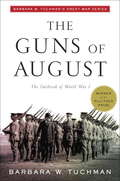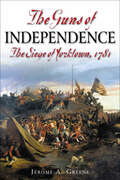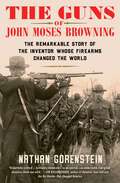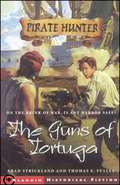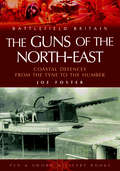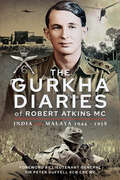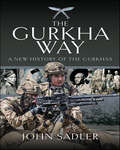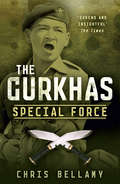- Table View
- List View
The Gun Garden
by David BeatyA young Royal Air Force Pilot is sent on a dangerous mission in Malta in this WWII novel of love and war. Malta, 1942. As the Second World War rages, the strategically vital Mediterranean island of Malta is isolated, desperately short of supplies, and slowly being starved into surrender. Into this hopeless situation, the British send two Wellington aircraft equipped with secret long-range radar. Their role is to find enemy convoys proceeding at night from Italy to Africa, and to lead a tiny naval force through the darkness to their unsuspecting target. One is captained by a veteran R.A.F. pilot, the other is flown by Peter Forrester, a young and hastily trained kid is about to have his carefree spirit tested by the maelstrom of war. Thrown into this island of heroes, Peter also meets Miranda Black, daughter of a naval captain and a plotter in Barracca H.Q. Written by acclaimed author and R.A.F. veteran David Beaty, The Gun Garden is an authentic tale of gritty battle and young love.
The Gun Garden
by David BeatyIn the unpredictable maelstrom of war, heroes can come from the unlikeliest places...Malta, 1942 – a thousand miles from friends, isolated, besieged, and slowly being starved into surrender…Into that hopeless situation fly two Wellington aircraft equipped with long-range radar. One is captained by a dedicated, veteran RAF pilot. The other by Peter Forrester, a hastily trained, carefree twenty-one-year-old.Their role is to find enemy convoys proceeding at night from Italy to Africa, and to lead a tiny naval force of cruiser and destroyer through the darkness to the unsuspecting target. The fate of a nation depends on their success...Climaxed by the mounting crescendo of a night battle at sea, this is a delicately balanced novel, caught between extremes of love and war, between guns and gardens.
The Gun Ketch: The Naval Adventures of Alan Lewrie (The Naval Adventures of Alan Lewrie #5)
by Dewey LambdinA fighter, rogue, and ladies man, Alan Lewrie has done the unthinkable and gotten himself hitched—to a woman and a ship! The woman is the lovely Caroline Chiswick. The ship is the gun ketch Alacrity, bound for the Bahamas and a bloody game of cat and mouse with the pirates who ply the lunatic winds there. But while war comes naturally to the young husband, politics doesn't. Sure that a powerful Bahamian merchant is behind a scourge of piracy, Lewrie runs afoul of the Royal Governor--who holds the most precious hostage of all.... From the windswept Carolinas to the exotic East Indies, Alan Lewrie fights and frolics with all the wild abandon of the high seas themselves. He's a true swashbuckling naval hero in the age of great sailing ships.
The Gun, the Ship and the Pen: Warfare, Constitutions and the Making of the Modern World
by Linda Colley'If there were a Nobel Prize in History, Colley would be my nominee' Jill Lepore, New Yorker'One of the most exciting historians of her generation, but also one of the most interesting writers of non-fiction around' - William Dalrymple, Guardian'Colley takes you on intellectual journeys you wouldn't think to take on your own, and when you arrive you wonder that you never did it before' - David Aaronovitch, the Times'A global history of remarkable depth, imagination and insight' Tony Barber, Financial Times Summer BooksStarting not with the United States, but with the Corsican constitution of 1755, The Gun, the Ship, and the Pen moves through every continent, disrupting accepted narratives. Both monarchs and radicals play a role, from Catherine the Great of Russia, with her remarkable Nakaz, to Sierra Leone's James Africanus Horton, to Tunisia's Khayr-al-Din, a creator of the first modern Islamic constitution. Throughout, Colley demonstrates how constitutions evolved in tandem with warfare, and how they have functioned to advance empire as well as promote nations, and worked to exclude aswell as liberate.Whether reinterpreting Japan's momentous 1889 constitution, or exploring the significance of the first constitution to enfranchise all adult women on Pitcairn Island in the Pacific in 1838, this is one of the most original global histories in decades.
The Gun: The AK-47 and the Evolution of War
by C. J. ChiversAt a secret arms-design contest in Stalin's Soviet Union, army technicians submitted a stubby rifle with a curved magazine. Dubbed the AK-47, it was selected as the Eastern Bloc's standard arm. Scoffed at in the Pentagon as crude and unimpressive, it was in fact a breakthrough--a compact automatic that could be mastered by almost anyone, last decades in the field, and would rarely jam. Manufactured by tens of millions in planned economies, it became first an instrument of repression and then the most lethal weapon of the Cold War. Soon it was in the hands of terrorists.In a searing examination of modern conflict and official folly, C. J. Chivers mixes meticulous historical research, investigative reporting, and battlefield reportage to illuminate the origins of the world's most abundant firearm and the consequences of its spread. The result, a tour de force of history and storytelling, sweeps through the miniaturization and distribution of automatic firepower, and puts an iconic object in fuller context than ever before. The Gun dismantles myths as it moves from the naïve optimism of the Industrial Revolution through the treacherous milieu of the Soviet Union to the inside records of the Taliban. Chivers tells of the 19th-century inventor in Indianapolis who designs a Civil War killing machine, insisting that more-efficient slaughter will save lives. A German attaché who observes British machine guns killing Islamic warriors along the Nile advises his government to amass the weapons that would later flatten British ranks in World War I. In communist Hungary, a locksmith acquires an AK-47 to help wrest his country from the Kremlin's yoke, beginning a journey to the gallows. The Pentagon suppresses the results of firing tests on severed human heads that might have prevented faulty rifles from being rushed to G.I.s in Vietnam. In Africa, a millennial madman arms abducted children and turns them on their neighbors, setting his country ablaze. Neither pro-gun nor anti-gun, The Gun builds to a terrifying sequence, in which a young man who confronts a trio of assassins is shattered by 23 bullets at close range. The man survives to ask questions that Chivers examines with rigor and flair.Throughout, The Gun animates unforgettable characters--inventors, salesmen, heroes, megalomaniacs, racists, dictators, gunrunners, terrorists, child soldiers, government careerists, and fools. Drawing from years of research, interviews, and from declassified records revealed for the first time, he presents a richly human account of an evolution in the very experience of war.
The Gunners of August 1914: Baptism of Fire
by John HuttonThe Great War will always be synonymous with trench warfare and the mass slaughter inflicted by machine guns on the helpless but gallant infantry. There is a good reason for this view as the machine guns took a terrible toll, and the infantry's experiences continue to fascinate and appal people today. But one aspect of the fighting that gets insufficient attention is the artillery. Histories of the major battles often reduce the role of the big guns to a few paragraphs, and this has created a seriously distorted impression of the reality of the fighting. A better balance needs to be struck, and that is the intention of John Hutton's new book on the gunners of 1914.He tells the story of the war as the gunners themselves saw it, focusing on the first few months of warfare which were fundamental to the conduct of the campaign. The gunners may not have always shared the trench experiences of the infantry in the front line, but they were in the thick of the action, and success or failure depended on them. The personal testimonies of those who served with and supported the guns provide a vital insight into the colossal tragedy and drama of the war from the artilleryman's point of view.
The Gunning of America: Business and the Making of American Gun Culture
by Pamela HaagAmericans have always loved guns. This special bond was forged during the American Revolution and sanctified by the Second Amendment. It is because of this exceptional relationship that American civilians are more heavily armed than the citizens of any other nation.Or so we're told.In The Gunning of America, historian Pamela Haag overturns this conventional wisdom. American gun culture, she argues, developed not because the gun was exceptional, but precisely because it was not: guns proliferated in America because throughout most of the nation's history, they were perceived as an unexceptional commodity, no different than buttons or typewriters.Focusing on the history of the Winchester Repeating Arms Company, one of the most iconic arms manufacturers in America, Haag challenges many basic assumptions of how and when America became a gun culture. Under the leadership of Oliver Winchester and his heirs, the company used aggressive, sometimes ingenious sales and marketing techniques to create new markets for their product. Guns have never "sold themselves"; rather, through advertising and innovative distribution campaigns, the gun industry did. Through the meticulous examination of gun industry archives, Haag challenges the myth of a primal bond between Americans and their firearms. Over the course of its 150 year history, the Winchester Repeating Arms Company sold over 8 million guns. But Oliver Winchester-a shirtmaker in his previous career-had no apparent qualms about a life spent arming America. His daughter-in-law Sarah Winchester was a different story. Legend holds that Sarah was haunted by what she considered a vast blood fortune, and became convinced that the ghosts of rifle victims were haunting her. She channeled much of her inheritance, and her conflicted conscience, into a monstrous estate now known as the Winchester Mystery House, where she sought refuge from this ever-expanding army of phantoms.In this provocative and deeply-researched work of narrative history, Haag fundamentally revises the history of arms in America, and in so doing explodes the clichés that have created and sustained our lethal gun culture.
The Gunpowder Age: China, Military Innovation, and the Rise of the West in World History
by Tonio AndradeThe Chinese invented gunpowder and began exploring its military uses as early as the 900s, four centuries before the technology passed to the West. But by the early 1800s, China had fallen so far behind the West in gunpowder warfare that it was easily defeated by Britain in the Opium War of 1839-42. What happened? In The Gunpowder Age, Tonio Andrade offers a compelling new answer, opening a fresh perspective on a key question of world history: why did the countries of western Europe surge to global importance starting in the 1500s while China slipped behind?Historians have long argued that gunpowder weapons helped Europeans establish global hegemony. Yet the inhabitants of what is today China not only invented guns and bombs but also, as Andrade shows, continued to innovate in gunpowder technology through the early 1700s--much longer than previously thought. Why, then, did China become so vulnerable? Andrade argues that one significant reason is that it was out of practice fighting wars, having enjoyed nearly a century of relative peace, since 1760. Indeed, he demonstrates that China--like Europe--was a powerful military innovator, particularly during times of great warfare, such as the violent century starting after the Opium War, when the Chinese once again quickly modernized their forces. Today, China is simply returning to its old position as one of the world's great military powers.By showing that China's military dynamism was deeper, longer lasting, and more quickly recovered than previously understood, The Gunpowder Age challenges long-standing explanations of the so-called Great Divergence between the West and Asia.
The Guns Above: A Signal Airship Novel (The Signal Airship Novels #1)
by Robyn BennisRobyn Bennis’s THE GUNS ABOVE is an adventurous military fantasy debut about a nation's first female airship captain.They say it’s not the fall that kills you. For Josette Dupre, the Corps’ first female airship captain, it might just be a bullet in the back. On top of patrolling the front lines, she must also contend with a crew who doubts her expertise, a new airship that is an untested deathtrap, and the foppish aristocrat Lord Bernat, a gambler and shameless flirt with the military know-how of a thimble. Bernat’s own secret assignment is to catalog her every moment of weakness and indecision. So when the enemy makes an unprecedented move that could turn the tide of the war, can Josette deal with Bernat, rally her crew, and survive long enough to prove herself?“Full of sass and terrific characters. Great storytelling. Loved it.” —Patricia BriggsAt the Publisher's request, this title is being sold without Digital Rights Management Software (DRM) applied.
The Guns at Gettysburg
by Fairfax Davis DowneyThe guns still stand at Gettysburg amid the markers and the monuments on the hallowed ground. And it is fitting that they do, for Gettysburg marked not only the high tide of the Confederacy and the turning point of the war, but also the greatest cannonade ever seen in this hemisphere. In no battle of the Civil War did artillery play a more decisive role than it did here, and no factor contributed more to the Union victory than the superior handling of the Federal cannon. Amid all the discussions of the errors of generalship on both sides, too little credit has been given to that all-but-forgotten hero of the battle, General Henry Jackson Hunt, the chief of the Union artillery. In reappraising and retelling the battle form the artilleryman’s point of view, Colonel Downey has made a real contribution to our understanding of the reasons for the Confederate failure to crush the Army of the Potomac.
The Guns at Last Light: The War in Western Europe, 1944-1945 (The Liberation Trilogy #3)
by Rick Atkinson<p>The magnificent conclusion to Rick Atkinson's acclaimed Liberation Trilogy about the Allied triumph in Europe during World War II. It is the twentieth century's unrivaled epic: at a staggering price, the United States and its allies liberated Europe and vanquished Hitler. <p>In the first two volumes of his bestselling Liberation Trilogy, Rick Atkinson recounted how the American-led coalition fought through North Africa and Italy to the threshold of victory. Now, in <i>The Guns at Last Light</i>, he tells the most dramatic story of all, the titanic battle for Western Europe. <p>D-Day marked the commencement of the final campaign of the European war, and Atkinson's riveting account of that bold gamble sets the pace for the masterly narrative that follows. The brutal fight in Normandy, the liberation of Paris, the disaster that was Operation Market Garden, the horrific Battle of the Bulge, and finally the thrust to the heart of the Third Reich-all these historic events and more come alive with a wealth of new material and a mesmerizing cast of characters. <p>Atkinson tells the tale from the perspective of participants at every level, from presidents and generals to war-weary lieutenants and terrified teenage riflemen. When Germany at last surrenders, we understand anew both the devastating cost of this global conflagration and the enormous effort required to win the Allied victory. <p>With the stirring final volume of this monumental trilogy, Atkinson's accomplishment is manifest. He has produced the definitive chronicle of the war that unshackled a continent and preserved freedom in the West.</p>
The Guns of August: The Outbreak of World War I
by Barbara W. TuchmanIn this landmark account, renowned historian Barbara W. Tuchman re-creates the first month of World War I: thirty days in the summer of 1914 that determined the course of the conflict, the century, and ultimately our present world. Beginning with the funeral of Edward VII, Tuchman traces each step that led to the inevitable clash. And inevitable it was, with all sides plotting their war for a generation. Dizzyingly comprehensive and spectacularly portrayed with her famous talent for evoking the characters of the war’s key players, Tuchman’s magnum opus is a classic for the ages.<P><P> Pulitzer Prize Winner
The Guns of Independence: The Siege of Yorktown, 1781
by Jerome A. GreeneA modern, scholarly account of the most decisive campaign during the American Revolution examining the artillery, tactics and leadership involved.The siege of Yorktown in the fall of 1781 was the single most decisive engagement of the American Revolution. The campaign has all the drama any historian or student could want: the war’s top generals and admirals pitted against one another; decisive naval engagements; cavalry fighting; siege warfare; night bayonet attacks; and much more. Until now, however, no modern scholarly treatment of the entire campaign has been produced.By the summer of 1781, America had been at war with England for six years. No one believed in 1775 that the colonists would put up such a long and credible struggle. France sided with the colonies as early as 1778, but it was the dispatch of 5,500 infantry under Comte de Rochambeau in the summer of 1780 that shifted the tide of war against the British.In early 1781, after his victories in the Southern Colonies, Lord Cornwallis marched his army north into Virginia. Cornwallis believed the Americans could be decisively defeated in Virginia and the war brought to an end. George Washington believed Cornwallis’s move was a strategic blunder, and he moved vigorously to exploit it. Feinting against General Clinton and the British stronghold of New York, Washington marched his army quickly south. With the assistance of Rochambeau's infantry and a key French naval victory at the Battle off the Capes in September, Washington trapped Cornwallis on the tip of a narrow Virginia peninsula at a place called Yorktown. And so it began.Operating on the belief that Clinton was about to arrive with reinforcements, Cornwallis confidently remained within Yorktown’s inadequate defenses. Determined that nothing short of outright surrender would suffice, his opponent labored day and night to achieve that end. Washington’s brilliance was on display as he skillfully constricted Cornwallis’s position by digging entrenchments, erecting redoubts and artillery batteries, and launching well-timed attacks to capture key enemy positions. The nearly flawless Allied campaign sealed Cornwallis’s fate. Trapped inside crumbling defenses, he surrendered on October 19, 1781, effectively ending the war in North America.Penned by historian Jerome A. Greene, The Guns of Independence: The Siege of Yorktown, 1781 offers a complete and balanced examination of the siege and the participants involved. Greene’s study is based upon extensive archival research and firsthand archaeological investigation of the battlefield. This fresh and invigorating study will satisfy everyone interested in American Revolutionary history, artillery, siege tactics, and brilliant leadership.
The Guns of John Moses Browning: The Remarkable Story of the Inventor Whose Firearms Changed the World
by Nathan GorensteinA &“well-researched and very readable new biography&” (The Wall Street Journal) of &“the Thomas Edison of guns,&” a visionary inventor who designed the modern handgun and whose awe-inspiring array of firearms helped ensure victory in numerous American wars and holds a crucial place in world history.Few people are aware that John Moses Browning—a tall, humble, cerebral man born in 1855 and raised as a Mormon in the American West—was the mind behind many of the world-changing firearms that dominated more than a century of conflict. He invented the design used in virtually all modern pistols, created the most popular hunting rifles and shotguns, and conceived the machine guns that proved decisive not just in World Wars I and II but nearly every major military action since. Yet few in America knew his name until he was into his sixties. Now, author Nathan Gorenstein brings firearms inventor John Moses Browning to vivid life in this riveting and revealing biography. Embodying the tradition of self-made, self-educated geniuses (like Lincoln and Edison), Browning was able to think in three dimensions (he never used blueprints) and his gifted mind produced everything from the famous Winchester &“30-30&” hunting rifle to the awesomely effective machine guns used by every American aircraft and infantry unit in World War II. The British credited Browning&’s guns with helping to win the Battle of Britain. His inventions illustrate both the good and bad of weapons. Sweeping, lively, and brilliantly told, this fascinating book that &“gun collectors and historians of armaments will cherish&” (Kirkus Reviews) introduces a little-known legend whose impact on history ranks with that of the Wright Brothers, Thomas Edison, and Henry Ford.
The Guns of Tortuga
by Brad Strickland Thomas E. Fuller Dominick SaponaroSafe Harbor? Five months into their undercover search for the pirate Jack Steele, Captain Hunter and the Aurora head for the island of Tortuga to put in for repairs after a battle with a deadly Spanish ship. Davy Shea, now fifteen years old and accepted by the Aurora's crew, continues to help his uncle Patch in the ship's surgery, but Captain Hunter has a special mission for him. The Captain has learned that captured British officers are being held on the island for ransom from the Crown, and he is determined to rescue those officers, even risking the Aurora's cover. As a servant boy, Davy can easily pass among the various pirate groups thriving on Tortuga. But as Davy begins to uncover the many secrets and deceptions that shroud this beautiful island, he soon realizes that more is at stake than the lives of a few captured officers. A plan is in the works that will force the pirate hunters on the Aurora to make new alliances...and bring them face to face with former enemies.
The Guns of Victory
by George BlackburnFor the Canadian Soldiers who lived through the momentous battle for Normandy in the summer of 1944, it was inconceivable that the conflict in Europe could continue for another eight long months. The war was won, they thought, and to win it they had been pushed to what seemed like the limits of endurance. But ahead lay not only an enemy with no thoughts of surrender, but also appalling battle conditions reminiscent of the legendary miseries of Passchendaele. This much-anticipated sequel to The Guns of Normany picks up where its critically acclaimed predecessor leaves off, and it continues in the same absorbing, startlingly vivid style. After the battle for Normandy, Blackburn's 4th Field Regiment, with the rest of 1st Canadian Army, is called upon to pursue the enemy through the flooded Low Country, clearing the Scheldt estuary - a task equal to that of D-Day - and opening the port of Antwerp to allow for the huge influx of supplies necessary to press on against the German forces, now fighting with mounting desperation and ferocity. After enduring the worst winter in local memory, and spending yet another Christmas far from home, in the spring of 1945 the Canadians are thrust into the crucial Battle of the Rhineland, which will eventually allow Allied forces to plunge into the heart of the Reich.When victory comes, it is with no sense of triumph over a vanquished foe, but with the profoundest relief that this most terrible conflict in history is finally over.Told with Blackburn's now trademark sense of drama and eye for detail, this story of the desperate struggle for Europe becomes as large as life. It should fully establish Blackburn as the author of an acknowledged classic on the Second World War.From the Hardcover edition.
The Guns of the Northeast: Costal Defences from the Tyne to the Humber (Battlefield Britain)
by Joe FosterA graphic account of the defence of Hartlepool, Whitby and Scarborough against German seaborne raiders in 1914 and a detailed history the coastal defences that confronted the German navy. For the first time the author relates the wider story of the batteries of the Northeast of England and of the gunners who manned them in times of war and peace. His study covers all the coastal batteries from Northumberland and the Tyne, south through Wearside and Durham, Hartlepool and the Tees, to North Yorkshire and the Humber. Information on all the sites of the gun batteries along the coast is included. Published in association with the Heugh Battery Restoriation Trust.
The Guns of the South: A Novel
by Harry Turtledove"It is absolutely unique--without question the most fascinating Civil War novel I have ever read." Professor James M. McPherson, Pultizer Prize-winning BATTLE CRY OF FREEDOM. January 1864--General Robert E. Lee faces defeat. The Army of Northern Virginia is ragged and ill-equpped. Gettysburg has broken the back of the Confederacy and decimated its manpower.Then, Andries Rhoodie, a strange man with an unplaceable accent, approaches Lee with an extraordinary offer. Rhoodie demonstrates an amazing rifle: Its rate of fire is incredible, its lethal efficiency breathtaking--and Rhoodie guarantees unlimited quantities to the Confederates. The name of the weapon is the AK-47....Selected by the Science Fiction Book Club. A Main Selection of the Military Book Club.
The Gurkha Diaries of Robert Atkins MC: India and Malaya 1944 - 1958
by Robert Atkins MCHow fortunate it is that Robert Atkins wrote up his experiences as a young Gurkha officer in India and later Malaya as, seventy years on, they form an important contemporaneous record of two historically significant periods. When India was granted Independence in 1947, irreconcilable religious differences made Partition inevitable. His account of the death, destruction and suffering that he and his soldiers witnessed makes for traumatic yet compelling reading. In the aftermath of Independence the Gurkha Regiments were split between the Indian and British Armies and Robert returned to England and British service. Three years later on his way to fight in the Korean War, he was ordered to join 1st Battalion, 6th Gurkha Rifles engaged in the battle against communist terrorists, known as the Malayan Emergency. Robert saw more than his share of action over next seven years in this eventually successful but bitterly fought campaign. His courage and leadership earned him the Military Cross. The two diaries are introduced with helpful narratives setting each in their historical context. Written with admirable modesty, this superb personal account informs and entertains.
The Gurkha Mindset: 10 Lessons in Courage and Resilience
by Captain Kailash LimbuThe Gurkha Mindset distils the wisdom and experiences of a seasoned Gurkha soldier into ten powerful lessons for life and leadership.Drawing from over two decades of service in the British Army, including five tours in Afghanistan and deployments in Bosnia and Sierra Leone, Captain Kailash Limbu shares the core principles that have shaped his journey as a soldier and a man. Through the metaphor of the khukuri, a symbolic and essential tool for every Gurkha, he illustrates how mindset and behaviour are crucial to overcoming challenges, achieving success and leading with honour.Kailash reveals how the disciplined and courageous mindset of the Gurkhas can be applied to everyday life, helping readers manage emotions, foster teamwork, lead effectively and prioritise self-care. Each lesson is rooted in the simplicity and strength of the Gurkha way of life, offering practical insights that are both timeless and adaptable to any context.Whether you seek to enhance your personal life, advance in your career or simply find greater fulfilment, The Gurkha Mindset provides the tools to sharpen your focus, build resilience and embrace life's challenges with a warrior's spirit.
The Gurkha Mindset: 10 Lessons in Courage and Resilience
by Captain Kailash LimbuThe Gurkha Mindset distils the wisdom and experiences of a seasoned Gurkha soldier into ten powerful lessons for life and leadership.Drawing from over two decades of service in the British Army, including five tours in Afghanistan and deployments in Bosnia and Sierra Leone, Captain Kailash Limbu shares the core principles that have shaped his journey as a soldier and a man. Through the metaphor of the khukuri, a symbolic and essential tool for every Gurkha, he illustrates how mindset and behaviour are crucial to overcoming challenges, achieving success and leading with honour.Kailash reveals how the disciplined and courageous mindset of the Gurkhas can be applied to everyday life, helping readers manage emotions, foster teamwork, lead effectively and prioritise self-care. Each lesson is rooted in the simplicity and strength of the Gurkha way of life, offering practical insights that are both timeless and adaptable to any context.Whether you seek to enhance your personal life, advance in your career or simply find greater fulfilment, The Gurkha Mindset provides the tools to sharpen your focus, build resilience and embrace life's challenges with a warrior's spirit.
The Gurkha Mindset: 10 Lessons in Courage and Resilience
by Captain Kailash LimbuThe Gurkha Mindset distils the wisdom and experiences of a seasoned Gurkha soldier into ten powerful lessons for life and leadership.Drawing from over two decades of service in the British Army, including five tours in Afghanistan and deployments in Bosnia and Sierra Leone, Captain Kailash Limbu shares the core principles that have shaped his journey as a soldier and a man. Through the metaphor of the khukuri, a symbolic and essential tool for every Gurkha, he illustrates how mindset and behaviour are crucial to overcoming challenges, achieving success and leading with honour.Kailash reveals how the disciplined and courageous mindset of the Gurkhas can be applied to everyday life, helping readers manage emotions, foster teamwork, lead effectively and prioritise self-care. Each lesson is rooted in the simplicity and strength of the Gurkha way of life, offering practical insights that are both timeless and adaptable to any context.Whether you seek to enhance your personal life, advance in your career or simply find greater fulfilment, The Gurkha Mindset provides the tools to sharpen your focus, build resilience and embrace life's challenges with a warrior's spirit.
The Gurkha Way: A New History of the Gurkhas
by John SadlerIn the 18th century in the town of Gorkha, just north of Kathmandu, ruler Prithvi Narayan fought campaigns against his neighbors and the British. During the fighting his warriors, renowned for their aggression and courage, gained the respect of the British, who appreciated that the steadfast warriors would make excellent soldiers. Upon the declaration of peace in 1816, a partnership was born. This alliance would play a vital role in UK defense over the next two centuries, from surviving the Indian Mutiny of 1857 and fighting in the jungles of Burma to the Khyber Pass, which would keep the Gurkhas in action for ninety years. The First World War sent the Regiment to the trenches, where battalion after battalion was decimated. Some 20 Gurkha battalions were deployed in the Second World War, which was soon increased to 45 following Dunkirk. Around 250,000 Gurkha soldiers would serve and were deployed most significantly in North Africa but also served with distinction in the Italian Campaign and Monte Cassino, as well as the decisive battles of Imphal and Kohima in the Far East. while the Gurkhas saw a drop in overall numbers post-war, they have continued to make integral contributions to many operations, including the Falklands and in Afghanistan, which this book examines extensively, with a special focus on Operation Herrick. In The Gurkha Way, John Sadler tells the story of the Gurkhas from their inception to modern day through interviews, unpublished diaries and correspondence. With over 200 years' experience, these steadfastly loyal soldiers are a link to an imperial past but also a key component of the modern British army. There is no other comparable unit in any of the world’s armies, (with the obvious exception of the Indian Army), or one more respected and loved by the British.
The Gurkhas
by Chris BellamyThe Gurkhas have fought on behalf of Britain and India for nearly two hundred years. As brave as they are resilient, resourceful and cunning, they have earned a reputation as devastating fighters, and their unswerving loyalty to the Crown has always inspired affection in the British people. There are also now up to 40,000 Gurkhas in the million-strong army of modern India. But who are the Gurkhas? How much of the myth that surrounds them is true? Award-winning historian Chris Bellamy uncovers the Gurkhas' origins in the Hills of Nepal, the extraordinary circumstances in which the British decided to recruit them and their rapid emergence as elite troops of the East India Company, the British Raj and the British Empire. Their special aptitude meant they were used as the first British 'Special Forces'. Bellamy looks at the wars the Gurkhas have fought this century, from the two world wars through the Falklands to Iraq and Afghanistan and examines their remarkable status now, when each year 11,000 hopefuls apply for just over 170 places in the British Army Gurkhas. Extraordinarily compelling, this book brings the history of the Gurkhas, and the battles they have fought, right up to date, and explores their future.
The Gurkhas
by Chris BellamyThe Gurkhas have fought on behalf of Britain and India for nearly two hundred years. As brave as they are resilient, resourceful and cunning, they have earned a reputation as devastating fighters, and their unswerving loyalty to the Crown has always inspired affection in the British people. There are also now up to 40,000 Gurkhas in the million-strong army of modern India. But who are the Gurkhas? How much of the myth that surrounds them is true? Award-winning historian Chris Bellamy uncovers the Gurkhas' origins in the Hills of Nepal, the extraordinary circumstances in which the British decided to recruit them and their rapid emergence as elite troops of the East India Company, the British Raj and the British Empire. Their special aptitude meant they were used as the first British 'Special Forces'. Bellamy looks at the wars the Gurkhas have fought this century, from the two world wars through the Falklands to Iraq and Afghanistan and examines their remarkable status now, when each year 11,000 hopefuls apply for just over 170 places in the British Army Gurkhas. Extraordinarily compelling, this book brings the history of the Gurkhas, and the battles they have fought, right up to date, and explores their future.

